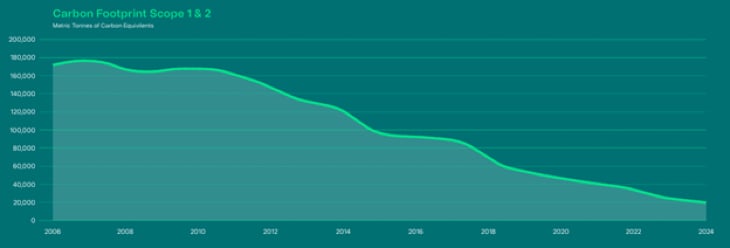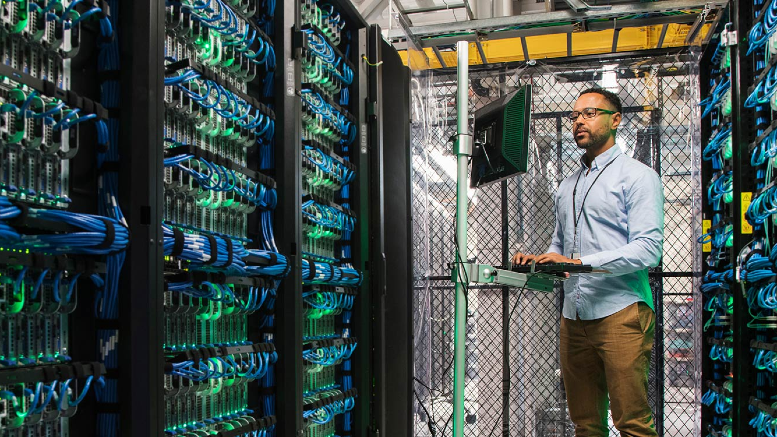
Climate change and carbon emissions
In 2006, we set a target to reduce our Scope 1 and 2 greenhouse gas (GHG) emissions by 75% by 2026. We accomplished this goal in 2021 – demonstrating our commitment by setting ambitious goals and taking action to shrink our carbon footprint.
Because we accomplished our previous goal, in 2022 we set a new target to achieve net zero GHG emissions for Scope 1 and 2 sources by 2030 as compared to our baseline year of 2020 (the Net Zero Goal)(1). This target received validation from SBTi in March 2023(2). We see SBTi validation as an important stamp of independent assurance that this near-term target is credible, anchored in sound science, and aligned with the Paris Climate Agreement’s goal of limiting global temperature increase to 1.5°C.
1 For purposes of this 2023 Sustainability Report, we define “net zero” as the state achieved when our anthropogenic Scope 1 and 2 GHG emissions to the atmosphere are balanced by anthropogenic removals. Our definition of net zero and our Net Zero Goal are limited to our Scope 1 and 2 GHG emissions sources. Our Net Zero Goal is not validated in connection with the Science Based Targets Initiative’s Corporate Net-Zero Standard or classified as a “net zero” target by the Science Based Targets initiative. Carbon offsets may be used here in addition to standard emissions reductions to obtain net zero emissions by 2030. Unisys reviews its GHG emissions reductions goals and targets, including Net Zero Goal, on an ongoing basis, and the goals and targets herein are subject to change.
2 SBTi deemed this target to conform with SBTi Criteria and Recommendations (version 4.2). This target was not validated in connection with SBTi’s Corporate Net-Zero Standard or classified as a “net zero” target by SBTi.
Our journey to net zero
Our journey to net zero is specific to Scope 1 and Scope 2 GHG emissions. Through 2023 we have already reduced our aggregated Scope 1 and Scope 2 GHG emissions by over 50% as compared to our baseline year.3

While our priority is to reduce our Scope 1 and 2 GHG emissions, we also intend to explore viable options to address residual, harder-to abate Scope 1 and 2 emissions. These include potential technological developments or tools such as renewable energy credits (to address Scope 2 emissions) and carbon credits (to support climate mitigation activities beyond our value chain).4
Compliance with California Assembly Bill No. 1305
California Assembly Bill No. 1305, the Voluntary Carbon Market Disclosure Act (“VCMDA”), requires certain disclosures, beginning January 1, 2025, for entities that operate in California and that make claims regarding the achievement of net zero emissions, claims that the entity or a product is carbon neutral, or other claims implying the entity or product does not add net carbon dioxide or GHGs to the climate or has made significant reductions to its carbon dioxide or GHG emissions. If such claims are made, an entity is required to disclose information documenting how such claims were determined to be accurate or accomplished, and how interim progress towards such goals are being measured.
The claims we make on this page regarding the accomplishment of our target to reduce Scope 1 and 2 GHG emissions by 75% by 2026 from 2006 levels, and regarding the reduction of our aggregated Scope 1 and 2 GHG emissions by over 50% as compared to our baseline year of 2020, are claims that fall under the disclosure requirements of the VCMDA, and the information contained on this page, together with information provided on pages 11-13 of our 2023 Sustainability Report and Section C7 of our 2024 Carbon Disclosure Project Report (linked below), provide the disclosures required under the VCMDA.
3 ISOS Group, Inc. (ISOS) has provided independent assurance of the energy consumption, Scope 1 and Scope 2 GHG emissions, and Scope 2 GHG emissions data in this report. GHG emissions were calculated using the operational control methodology specified in the GHG Protocol. Several smaller Scope 1 GHG emissions sources (e.g., refrigerant releases and mobile combustion sources) were excluded from ISOS’s review.
4 This webpage contains forward-looking statements within the meaning of Section 27A of the Securities Act of 1933, as amended, Section 21E of the Securities Exchange Act of 1934, as amended, and the Private Securities Litigation Reform Act of 1995. Unisys cautions readers that the assumptions forming the basis for forward-looking statements include many factors that are beyond Unisys’ ability to control or estimate precisely, such as GHG emissions, net zero, climate, carbon footprint, waste and diversity goals. Words such as “anticipates,” “estimates,” “expects,” “projects,” “may,” “will,” “intends,” “plans,” “believes,” “should” and similar expressions may identify forward-looking statements and such forward-looking statements are made based upon management’s current expectations, assumptions and beliefs as of January 1, 2025 concerning future developments and their potential effect upon Unisys. There can be no assurance that future developments will be in accordance with management’s expectations, assumptions and beliefs or that the effect of future developments on Unisys will be those anticipated by management. Forward-looking statements on this webpage include, but are not limited to, any statements, express or implied, of belief or expectation or aspirational statements concerning our expectations regarding our ESG commitments, targets, goals, initiatives, strategies and efforts and their impact on our business, future financial results, clients, employees and communities.

Leadership’s endorsement of our goal to reach net zero Scope 1 and Scope 2 GHG emissions by 2030 is a new milestone for Unisys. We hit our previous GHG emissions reduction target five years ahead of schedule, and now we’re scaling up our ambition.
Director of Global Environmental, Health, Safety and Security, Unisys
How we’re reducing our emissions
Five actions that enabled us to meet our previous target that will help us take aim at the next one.
1 - Innovating and deploying solutions that reduce our carbon footprint and those of our clients through our products and services
Our Digital Workplace Solutions are designed to optimize remote work; our Cloud Applications & Infrastructure and Enterprise Computing Solutions offer agility and efficiency and unlock innovation.
2 - Optimizing our real estate footprint
In the past five years, our real estate square footage has been reduced globally by about 25%.
3 - Reducing air and vehicle travel
GHG emissions per headcount in 2023 have been reduced by approximately 14% as compared to 2019.
4 - Increasing energy efficiency
Since 2019, our power consumption has been reduced globally by about 47%.
5 - Procuring renewable power
In 2023 use of renewable power at our Salt Lake City Data Center resulted in a reduction of approximately 4,000,000 kWh and over 1,400 metric tonnes of Scope 2 GHG emissions. In Hyderabad, India - We procured renewable power that reduced Scope 2 GHG emissions by over 200 metric tonnes.
These efforts in reducing emissions have led us to a 56% emissions reduction in just 5 years.
















